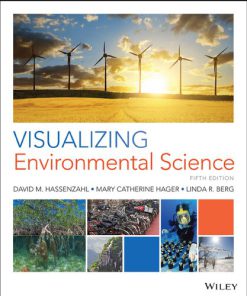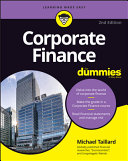Environmental Science For Dummies 2nd Edition by Alecia M Spooner ISBN 9781394161393 1394161395
$50.00 Original price was: $50.00.$25.00Current price is: $25.00.
Environmental Science For Dummies 2nd Edition by Alecia M Spooner – Ebook PDF Instant Download/Delivery: 9781394161393 ,1394161395
Full download Environmental Science For Dummies 2nd Edition after payment

Product details:
ISBN 10: 1394161395
ISBN 13: 9781394161393
Author: Alecia M Spooner
Ace your environmental science class and get smart about the environment
Environmental Science For Dummies is a straightforward guide to the interrelationships of the natural world and the role that humans play in the environment. This book tracks to a typical introductory environmental science curriculum at the college level–and is great as a supplement or study guide for AP Environmental Science, too. Uncover fascinating facts about the earth’s natural resources and the problems that arise when resources like air, water, and soil are contaminated by pollutants. If you’re in need of extra help for a class, considering a career in environmental science, or simply care about our planet and want to learn more about helping the environment, this friendly Dummies resource is a great place to start.
- The key concepts of environmental science, clearly explained
- All about the changing climate, including new understanding of methane release in the arctic
- Earth’s natural resources and the importance of protecting them
- A new chapter on environmental justice, where issues of poverty and sustainability intersect
A solid foundation in environmental science is essential for anyone looking for a career in the field–and is important knowledge for all of us as we work together to build a sustainable future.
Environmental Science For Dummies 2nd Edition Table of contents:
Part 1: Demystifying Science and the Environment
Chapter 1: Investigating the Environment
Putting the “Science” in Environmental Science
Analyzing the Earth’s Systems and Ecosystems
Supplies Limited! Natural Resources and Resource Management
Keeping Things Habitable
Imagining the Future
Chapter 2: Thinking Scientifically: The Scientific Method and Other Ways of Knowing
Asking and Answering Questions with the Scientific Method
Presenting Data Graphically
Quantifying Uncertainty
Recognizing Good Science When You See It
Knowing There Are Different Ways of Knowing
Chapter 3: What’s the Matter? Living and Nonliving Material
Changing States of Matter
Examining Atomic Structure
Making and Breaking Chemical Bonds
Surveying the Properties of Water
What’s pH Got to Do with It? Acids and Bases
It’s Alive! Organic Matter and Compounds
Building Organisms One Cell at a Time
Chapter 4: Making Things Happen: Energy
Identifying the Different Types of Energy
Defining the Thermodynamic Laws
Counting Calories (and Joules)
Converting the Sun’s Energy to a Useable Form
Chapter 5: Studying the Environment and Your Place in It
Integrating Multiple Disciplines
Applying Common Tools of Environmental Science
Tracing the Development of Modern Environmental Ethics
The Overall Goal: Seeking Sustainability
To Be or Not to Be a Tree-Hugger: Looking Past Political Debates
Part 2: Living on Earth’s Surface: Ecosystems, Biomes, and Climate
Chapter 6: Exploring Ecosystems
Understanding Systems
Systematically Understanding the Earth’s Environment
Transferring Energy and Matter through an Ecosystem
Chapter 7: Biogeography: How Earth’s Climate Shapes Global Ecosystem Patterns
Positioning Ecosystems: Latitude and Altitude
Recognizing Major Climate Drivers
Separating the Globe into Biomes
Chapter 8: Playing Well with Others: Population Biology
Characterizing a Population
Predicting Population Change
Watching Species Interact
From Indicator Species to Ecosystem Engineers: Filling Every Niche
Working Together: Biological Communities
The People Principle: Human Population Biology
Chapter 9: Heating Things Up: Living in a Changing Climate
Living on Earth
Mapping the climate system
Hothouse Humans: The Greenhouse Effect
Counting Greenhouse Gases
Considering Past, Present, and Future Climates
Feeling the Heat: Environmental Effects of Modern Climate Change
Tracking Dramatic Change
Living with an Unpredictable Climate
Part 3: Getting Your Needs Met: Earth’s Natural Resources
Chapter 10: Water, Water Everywhere: Freshwater Resources
Finding Fresh Water
Conserving Fresh Water
Thirsty for More: The Never-Ending Need for Fresh Water
Creating Fresh Water
Chapter 11: This Land Belongs to You and Me: Land as a Resource
Sharing Land
Managing Land Resources
Considering the Connection between Urbanization and Land Use
Chapter 12: Greater Than the Sum of Its Parts: Biodiversity
Variety Is the Spice of Life: Defining Biodiversity
Becoming Biodiverse: Evolution by Natural Selection
The HIPPO in the Room: Major Threats to Biodiversity
Creating Effective Conservation Plans
Chapter 13: Dishing It Up: Food Resources
Seeking Food Security
Defining Organic
Feeding the world: The green revolution
Digging in the Dirt: Components of Healthy Soil
The Pitfalls of Pesticides
Integrating Pest Management
“Frankenfood”: Genetically Modifying Food
Farming Fish and Other Animals
Establishing Sustainable Agriculture
Chapter 14: Hitting the Hard Stuff: Geologic Resources and Hazards
Getting to Know the Earth
Finding Value in Rocks
Extracting Geologic Resources
Forming and Depleting Fossil Fuels
Reacting to Nuclear Energy
Living on a Dynamic Planet
Chapter 15: Shifting Gears: Alternative Energy
Looking for Alternative Energy
Farming Fuel: Biofuel Energy Sources
Harnessing Energy from Water
Getting Steamed: Geothermal Energy
Soaking Up the Sun: Solar Energy
Chasing Windmills: Wind Energy
Energy on Demand: Creating Fuel Cells
Making the Most of the Energy You Already Have: Energy Conservation
Part 4: Giving a Hoot: Pollution and Environmental Quality
Chapter 16: Breathing Room: Addressing Man-Made Air Pollution
Sorting Out Common Pollutants
Observing the Effects of Air Pollution
Holy Ozone! Remembering the Hole in the Ozone Layer
The Air in There: Watching Out for Indoor Air Pollution
Clearing the Air
Chapter 17: Spilling Over: Water Pollution
Polluting Water in Many Ways
Getting to the Point (and Nonpoint) Source
Endangering Human Health
Disrupting Ecosystems
Breaking with Tradition: Wastewater Treatment and Constructed Wetlands
Chapter 18: What’s Your Poison? Toxins and Infectious Disease
Identifying Common Toxins
Sticking Around: Persistent Organic Pollutants
Understanding the Ins and Outs of Toxic Exposure
Risky Business: Assessing the Dangers of Chemicals
Tracking Infectious Disease
Chapter 19: Wading Through the Waste Stream: Solid and Hazardous Waste
Mapping the Life Cycle of Waste
Closing the Loop
Disposing of Waste
Swimming in Waste: The Ocean Garbage Patches
Reduce, Reuse, Recycle (and Compost): Shrinking the Waste Stream
Handling Hazardous Waste
Part 5: Expanding the Definition of Sustainability
Chapter 20: Reevaluating the Value of the Environment
Overlapping Spheres of Sustainability
Looking at Ecosystem Lessons
Counting Coins: Mainstream Economics
Tripling the Bottom Line
Exercising the Precautionary Principle
Looking at the World in New Ways
Taking It Personally
Setting Sustainability Goals
Chapter 21: Decolonizing Environmental Science
Understanding What’s at Stake
Rethinking Colonial Resource Extraction
Digging Up Indigenous Roots
Movers and Shakers: Indigenous Activists around the World
Recognizing Environmental Racism in the U.S.
Desperately Seeking Justice
From Sea to Shining Sea: Environmental Protection in the U.S.
Part 6: The Part of Tens
Chapter 22: Ten International Agreements on Planetary Stewardship
The Ramsar Convention on Wetlands
The Convention on International Trade in Endangered Species
The Convention on Biological Diversity
Stockholm Declaration
Montreal Protocol
UN Framework Convention on Climate Change
Convention for the Protection of the Mediterranean Sea Against Pollution
Basel, Rotterdam, and Stockholm Conventions (BRS)
Convention on the Conservation of Migratory Species of Wild Animals (CMS)
Convention Concerning the Protection of the World Cultural and Natural Heritage (or the World Heritage Convention)
Chapter 23: Ten Real-Life Examples of the Tragedy of the Commons
Grand Banks Fisheries
Fast Fashion
Bluefin Tuna
Passenger Pigeons
Ocean Garbage Gyres
Earth’s Atmosphere
Gulf of Mexico Dead Zone
Traffic Congestion
Transboundary Groundwater
Unregulated Logging
Index
People also search for Environmental Science For Dummies 2nd Edition:
environmental science for dummies pdf
environmental science main topics
basic principles of environmental science
environmental science for beginners
environmental science books for beginner
Tags: Alecia M Spooner, Environmental Science, Dummies
You may also like…
Computers - Programming
Computers - Programming
Computers - Databases
Earth Sciences
Applications of Hypothesis Testing for Environmental Science 1st Edition Abbas F. M. Alkarkhi
Computers - Computer Science
Graph Data Science (GDS) For Dummies 2nd Edition Alicia Frame
Engineering - Environmental
Education Studies & Teaching - Studying & Test Preparation
Series 7 Exam: 1001 Practice Questions For Dummies, 2nd Edition Steven M. Rice
Science (General)
Visualizing Environmental Science 5th Edition by David M. Hassenzahl 9781119279167 111927916X
Business & Economics - Professional Finance
Corporate Finance For Dummies (For Dummies (Business & Personal Finance)), 2nd Edition Taillard











